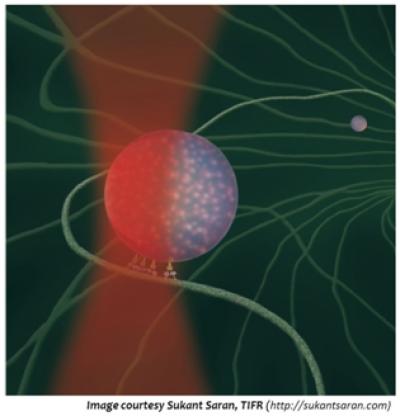Jan 18 2013
To live is to move. You strike to swat that irritable mosquito, which skilfully evades the hand of death. How did that happen? Who moved your hand, and what saved the mosquito? Enter the Molecular Motors, nanoscale protein-machines in the muscles of your hand and wings of the mosquito. You need these motors to swat mosquitoes, blink your eyes, walk, eat, drink... just name it. Millions of motors tug as a team within your muscles, and you swat the mosquito. This is teamwork at its exquisite best.
 A phagosome transported inside a living cell by molecular motors is held by a laser trap. This allows measurement of the picoNewton forces exerted by motors as they haul the phagosome inside the cell. Credit: Sukant Saran, TIFR
A phagosome transported inside a living cell by molecular motors is held by a laser trap. This allows measurement of the picoNewton forces exerted by motors as they haul the phagosome inside the cell. Credit: Sukant Saran, TIFR
Paradoxically, a weak and inefficient motor (called dynein) is the one that generates large forces in many different biological processes. Why has nature made this counter-intuitive choice? Scientists at TIFR, led by Dr. Roop Mallik, have discovered that a team of dyneins is able to share a load much larger than any one of them can handle, due to the unique ability of each dynein to change gears. Because of this, dynein's do much better at teamwork than other stronger motors that cannot change gears. This work will be published in the top-tier journal Cell in January 2013.
This is the PhD thesis work of Arpan Rai, who was ably supported by members of Mallik's team, Ashim Rai, Avin Ramaiya and Rupam Jha. This group of young students took a laser beam and focused it down to a tiny spot inside a mouse cell. Small objects inside the cell which were being moved around by motors could be trapped in this laser beam. Now, the motors tried their best to pull this object out of this "laser trap". The figure shows an artist's rendition of such an object being pulled out of the laser trap by four dynein motors. Mallik says: "Each dynein showed a special ability to shift gears, just like you shift gears in your car to go uphill. Therefore, each dynein in a team could speed up or slow down, depending how hard it was pulled back. This allowed the dyneins to bunch close together as they were pulling. The bunching helped dyneins to share their load equitably, and therefore work efficiently to generate large forces. Remarkably, motor-teams made up of another motor (called kinesin) which is much stronger than dynein, could not generate comparable forces. The reason? Well … you guessed it right. Kinesin does not have a gear!!"
Taken together, these new studies show that Nature may have learnt how to use the gear in a motor much before we made our Ferrari's and Lamborghini's. But, what boggles the mind is that dynein's gear works on a size scale that is ten-million times smaller than the Ferrari's gear.